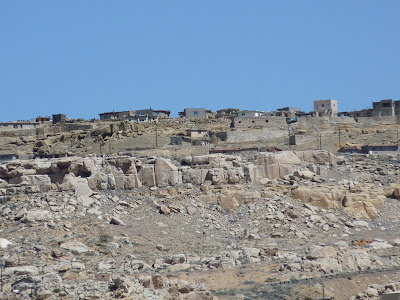Sunday, May 1, 2022
Tuesday, April 9, 2013
Navajo Country
The Navajo Nation encompasses about 25,000 square miles, mostly in Arizona but also extends into Utah and New Mexico.
Most Navajo speak English to some degree, but Navajo is frequently used and for some it is their only language. Radio stations broadcast in both English and Navajo languages.
Today there are approximately 175,228 people living in Navajo country. We stayed last night at the visitors center in Window Rock, Az., capitol of the Navajo Nation.
Small herds of sheep, goats, cattle and horses are common here. This is open range country and herds move freely along and across roads.
Hogans are the traditional homes of the Navajo. They also serve as places for ceremonies. They may be eight sided (female) or six sided (male) and are built from whatever material is readily available.
The doorway always faces east to welcome the new day. Many do not have electricity or running water and most are heated with a central wood-burning stove.
Navajos live in family groups spread throughout the nation. Small clusters of hogans, trailers and a house or two may signify more than one generation of a family.
In 1965, Congress made Hubbell Trading Post a national historic site and it continues to be a working trading post today.
You can still buy cowboy coffee, Blue Bird flour, pottery, jewelry and baskets here.
The Hubbell long gun collection represents a continual progression of new and improved gun models. It contains an evolution of firearms technology from the early smoothbore muzzle-loaders to the famous Winchester rifle.
Traditionally, the male hogan is where ceremonies are held and war plans are made. It is generally considered a very aggressive place. The female hogan is where the family stays. It is filled with love, peace and kindness.
Sunday, April 7, 2013
Hopiland
After a wonderful Hopi meal, we spent the night camped next to the Hopi Cultural Center on Second Mesa of the Hopi Reservation. This is Hopiland.
Completely surrounded by the Navajo Nation, here is found the oldest continuously inhabited community in the United States. The first mesa-top villages were settled around 1125 AD.
In the morning we met our guide, who took us to his ancestral village of Mishongovi on Second Mesa, where he still lives.

There are twelve Hopi villages on three mesas with about 10,000 Hopi living here in Hopiland and about 7,000 more Hopi around the world. Few outsiders come here and there are very strict rules for those who do. Our visit would not have been possible without our guide.
We met several villagers and were invited into their homes. We were shown their personal kachina collections and were able to purchase a original kachina from a craftsman in his home.
This is a children's kachina from the Badger Clan.
People have continuously lived here in the same ancestral houses clinging to the edges of this rocky escarpment for over 800 years.
Photography is banned, but is limited with a guide. So here are the few pictures we were able to take.
This house belongs to our guides wife's grandmother and has a commanding view of the whole valley below and the distant San Francisco peaks. She has lived here her whole life, as have most of the few remaining villagers.
Judy with our guide Lamar Honyaketewa and the view from his wife's grandmothers house. Lamar is a member of the Bear Clan. The view extends for over one hundred miles.
Holes in the rocks were used for ancient ceremonies, many of which are very unique and are still observed today.
The cemetery on the overlook below. The mesa cliffs abruptly drop 600 feet to the valley below.
A typical home that has been continuously inhabited with almost no change for over 800 years.
The roofs are made of logs, sticks and clay.
Fields of corn, squash, melons and peaches are far below. Wealth here is still measured in how much corn one has. Planting is done by hand with a traditional planting stick, and many prayers and ceremonies take place to insure a good crop.
Water and electricity are very limited, with most homes having none. There are community outhouses and a community well. There is limited propane use, with most homes heated with coal obtained from a distant mine.
Many ancient rituals are still adhered to. The above photo shows clan Kivas with ladders sticking from the roofs. These are occupied by the Kachinas during ceremonies. We hope to come back here to observe a ceremony, and our guide has a parking spot for us! To learn more about the Hopi: http://www.experiencehopi.com.
Friday, April 5, 2013
Our Life Is In Ruins
Wupatki National Monument covers 56 square miles of rugged land 38 miles north east of Flagstaff. It protects a number of ancient ruins of puebloan peoples.
This monument contains over 800 ruins and had a population of over 4,000 people.
It was a multi-level high-rise pueblo with about 100 rooms.
There is a ceremonial ballcourt.
It had a community room that served as a meeting place.
Subscribe to:
Comments (Atom)



























































